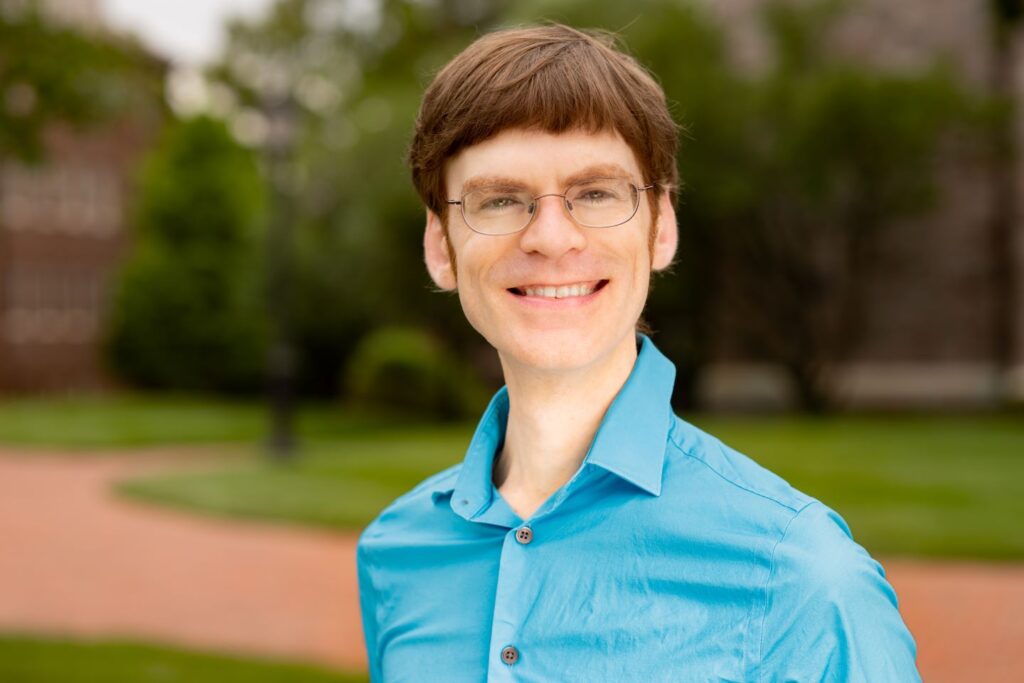Highlighting our faculty
- Faculty at Lafayette College are renowned leaders in their respective fields, exceptional teachers and dedicated mentors. Read more about our faculty.
Learn more about Brooks Thomas, associate professor of physics

Research area: While my work has focused primarily on identifying the nature and properties of the mysterious dark matter in our universe, one of the things I’ve been doing over the past couple of years is branching out into other aspects of cosmology—the study of how the universe evolved to look the way that it looks today, and what its properties might teach us about fundamental physics and the nature of space and time.
For example, we still don’t have a definitive answer as to why the universe contains so much more matter than antimatter. Matter and antimatter annihilate when they come together, and we don’t see galaxies made of matter annihilating with galaxies made of antimatter when we look out at the universe. Why is this the case when the laws of physics are almost exactly the same for matter and antimatter? The answers to questions like this, believe it or not, can have a lot to do with what occurred within the first few seconds of our universe’s history.
The spatial distribution of matter throughout the universe—how smooth or clumpy it is— can also provide us with clues about fundamental physics. Over the past 20 years, for example, we’ve been discovering more and more little satellite galaxies that orbit our own Milky Way galaxy like planets orbiting around a star. Why do such small galaxies exist at all? Why aren’t there more of them? The answers to these questions have a lot to do with dark matter, but they have a lot to do with the history of our universe as well.
When exploring the possibilities for how our universe might have come to look the way it does, I try to take as broad a perspective as possible. Did the universe perhaps evolve in some weird way that differs from the canonical cosmological timeline that people have assumed for half a century? If so, how could we tell?
My Lafayette journey:“I went to Macalester College as an undergraduate. Macalester is a small liberal arts institution very similar to Lafayette, with very small class sizes and myriad opportunities to interact directly with faculty members. That kind of environment made it possible for me to explore many different areas of intellectual pursuit. I actually thought at first that I was going to be a literary critic or a professor of English. I loved literature. I loved James Joyce. However, I was required to take a couple of natural science courses in order to fulfill Macalester’s equivalent of the Common Course of Study. I had a strong math background—my dad was a high school math teacher, so I had a leg up in that subject—so during my sophomore year I decided to take the physics and chemistry courses that a first-year major in those subjects would take. It became apparent to me a few weeks into my introductory mechanics class that this was what all of the math I’d been learning for years was really designed for. A whole new way of looking at the world was opening up to me, and I thought ‘I have to pursue this.’ And pursue it I did.
I was drawn to Lafayette because I loved the plurality of interests that people have who gravitate toward a liberal arts setting. My faculty colleagues here are not only deeply interested in the world around them, but also love to talk about it. That’s kind of the environment in which I really felt I belonged. Another consideration for me was that while I love theoretical particle physics, it isn’t a field where new advances typically have a direct impact on the human condition. I wanted to be at a teaching-focused institution like Lafayette in part because teaching physics is a way in which I can have a tangible impact on people’s lives while at the same time getting to pursue the kinds of research questions that interest me the most.
What I will be teaching in the fall: I’ll be teaching a course on quantum mechanics. And I’ll also be teaching an FYS on science policy, in which my students and I will explore topics such as how societies attempt to mobilize scientific activity for the common good, why those efforts don’t always succeed, and how scientists can most effectively communicate their ideas to a broad range of audiences in writing. In one activity, for example, each student writes a mock grant proposal, which is then reviewed anonymously by a panel of other students according to the review protocols followed at funding agencies like the National Science Foundation.